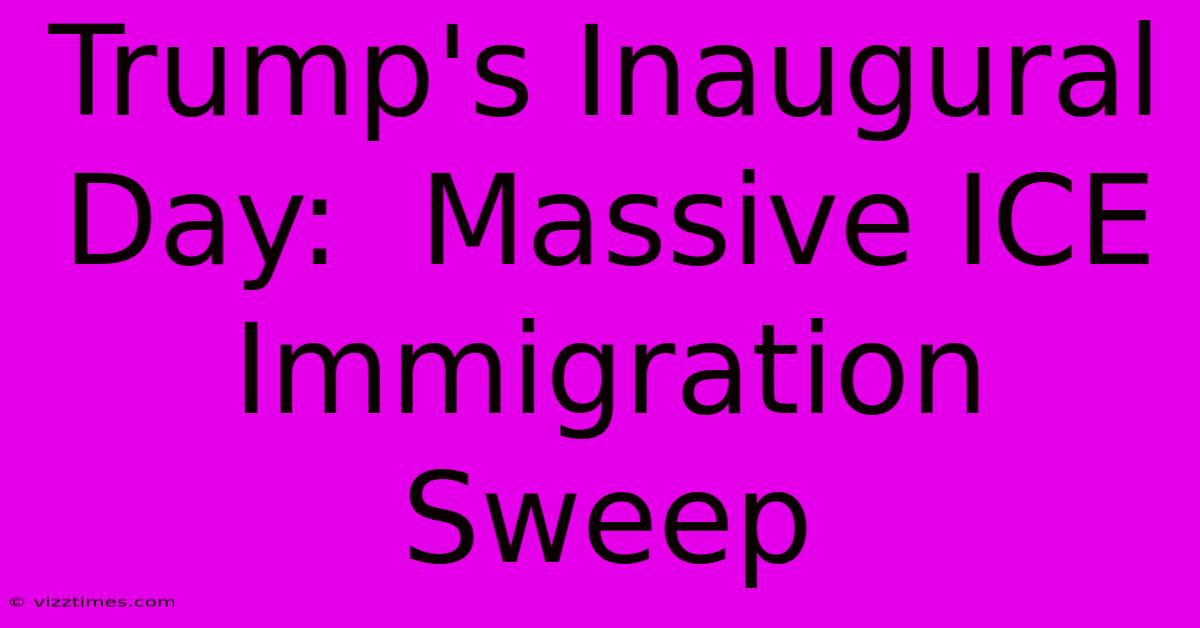Trump's Inaugural Day: Massive ICE Immigration Sweep

Table of Contents
Trump's Inaugural Day: The Myth of the Massive ICE Immigration Sweep
Okay, folks, let's talk about something that's been floating around for years – the rumor of a huge ICE raid on Inauguration Day 2017. It's a story that's popped up again and again, fueled by anxiety and misinformation. So, let's dive in and separate fact from fiction. I’ll share my experience researching this, because believe me, it was a wild ride.
The Story That Wouldn't Die
You've probably heard the whispers: A massive ICE operation, targeting undocumented immigrants on Donald Trump's inauguration day. Thousands swept up, families torn apart – the whole shebang. It sounds scary, right? And that's exactly why this story stuck around. Fear is a powerful motivator, especially when it's tied to political narratives.
I first heard this story from a friend who'd seen it shared on Facebook – you know, that place where truth and fiction get all mixed up. At first, I kinda dismissed it as just another viral hoax. But then I saw it mentioned on other news sites – some reliable, some… less so. My spidey senses started tingling. Something didn't smell right. This wasn't just some random internet meme. It felt...organized.
The Reality Check: Digging for the Truth
So, I did what any self-respecting news hound would do: I started digging. I looked at official ICE statements, news reports from reputable sources, and even dug through some obscure government documents. And you know what? The claims of a massive, coordinated nationwide sweep on Inauguration Day simply didn't pan out. There was no evidence. Zero. Zilch. Nada.
Sure, ICE did conduct some enforcement actions around that time – that's their job, after all. But nothing on the scale that was being claimed. The numbers were wildly inflated. Stories were exaggerated and combined, creating a monster of misinformation.
It turned out the claims were based on a few localized incidents, some anecdotal accounts, and a whole lot of speculation. Think of it like a game of telephone, but instead of whispered secrets, it was fear-mongering. The information got twisted and amplified with each retelling.
Why This Myth Persisted (and Still Does)
Why did this false narrative stick? Well, several factors played a role:
-
Political Climate: Trump's campaign rhetoric on immigration was quite strong, fueling anxieties among immigrant communities. This created fertile ground for this kind of misinformation to spread. People were already scared, making them more susceptible to believing this exaggerated claim.
-
Confirmation Bias: People tended to believe what confirmed their existing biases. If someone already distrusted the Trump administration, this story confirmed their suspicions. It's a classic case of seeing what you want to see and ignoring contradictory evidence. It's human nature, unfortunately.
-
Social Media's Role: Social media platforms played a major role in the spread of this myth. News travels fast online, especially when it's sensational. The speed of information spread often far outpaced accuracy verification.
-
Lack of Media Literacy: Many people didn’t have the critical thinking skills to evaluate the reliability of information they encountered online. It’s crucial to check multiple sources and verify information before sharing it.
What We Can Learn
This whole experience taught me a valuable lesson: Don't believe everything you read on the internet. Always, always, ALWAYS verify information from multiple, credible sources. Especially when it comes to sensitive topics like immigration, where misinformation can have real-world consequences. And also, my social media feeds need a serious cleanup!
Practical Tips for Spotting Fake News
Seriously, folks, we're living in the age of misinformation, and it's crucial to develop your critical thinking skills. Here are a few tips to help you spot fake news:
-
Check the source: Is it a reputable news organization or a questionable blog? Look for established sources with a history of accurate reporting.
-
Look for evidence: Does the story provide credible evidence to support its claims? Are there sources cited?
-
Consider the tone: Is the story presented objectively or emotionally? Sensational headlines and emotionally charged language are often warning signs.
-
Read beyond the headline: Don't just skim the headline. Read the entire article carefully and critically.
-
Compare across multiple sources: See if other reputable news organizations are reporting the same story.
-
Beware of emotionally charged language: Fake news often utilizes strong, emotionally charged language designed to stir up fear, anger, or outrage.
This Inauguration Day myth serves as a potent reminder of the power of misinformation and the importance of media literacy. It's something we all need to be aware of in today's rapidly evolving information landscape. Stay vigilant, stay informed, and always question what you see. It's up to us to combat the spread of fake news! Don't let yourself get fooled. Stay safe out there, folks.

Also read the following articles
| Article Title | Date |
|---|---|
| All The 2025 Oscar Nominations See Who Got The Nod | Jan 24, 2025 |
| Fernandes Late Goal Man United Edges Victory Sons Spurs Shine | Jan 24, 2025 |
| 2025 Academy Awards See Every Nominee In Every Category | Jan 24, 2025 |
| Scouting Report What Type Of Player Does Manchester United Need From Romania | Jan 24, 2025 |
| Trumps New Crypto Coin Is It A Joke Or A Scam | Jan 24, 2025 |